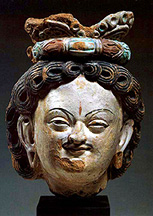
Found at the Cave of the Statues, Kizil, near Kucha
Xinjiang Province, China
6th century CE
Ink and mineral pigments on clay
Height: 27 cm
Acquisition number: #MIK III 7882
Image courtesy of the Museum für Indische Kunst (copyright reserved)
Staatliche Museen zu Berlin - Preussischer Kulturbesitz
The influence of Indian art (particularly that of the Buddhist caves at Ajanta) is very strongly visible in the features of this bodhisattva head, one of the many statue fragments found in the Cave of Statues at the Kucha oasis near Kizil. As noted by Herbert Härtel and Marianne Yaldiz, a great number of stucco molds have been recovered in this area, some even bearing the names of their craftsmen owners written in Sanskrit (1), indicating that these sculptures were mass-produced.
The method of production was similar to that used for clay images in the Mogao Caves near Dunhuang, such as the main icon found in Cave 275, with the basic shape for images created by packing clay reinforced with straw or animal hair around a wooden frame. By using molds, however, the process would have allowed for faster and more uniform production. Nonetheless, a high degree of individuality is achieved in the last stages of the process, when the last facial features and details are added with a paintbrush. These faces are very similar to those seen in the bodhisattvas in painted murals of the same period at Kizil, allowing us to imagine that the same painters worked on both the wall paintings and on decorating these clay statues.
(1) Härtel, Herbert and Marianne Yaldiz, Along the Ancient Silk Routes: Central Asian Art from the West Berlin State Museums (New York: Metropolitan Museum of Art, 1982), p. 70.